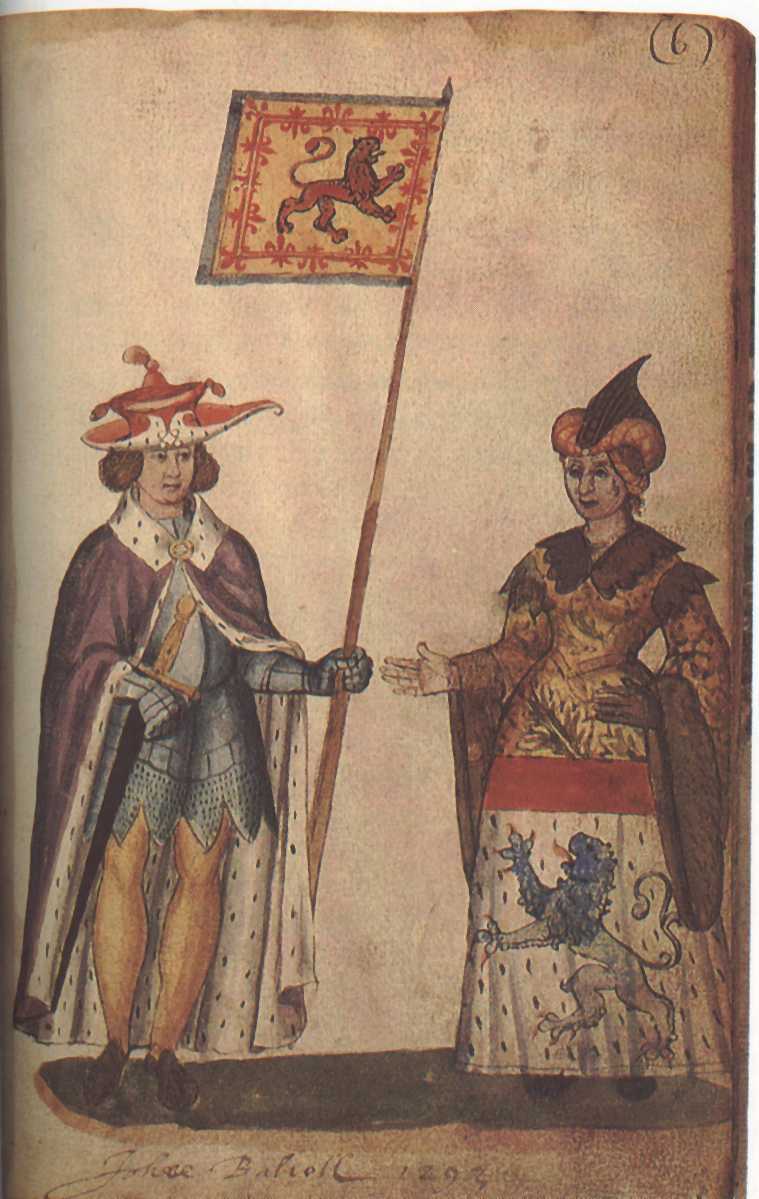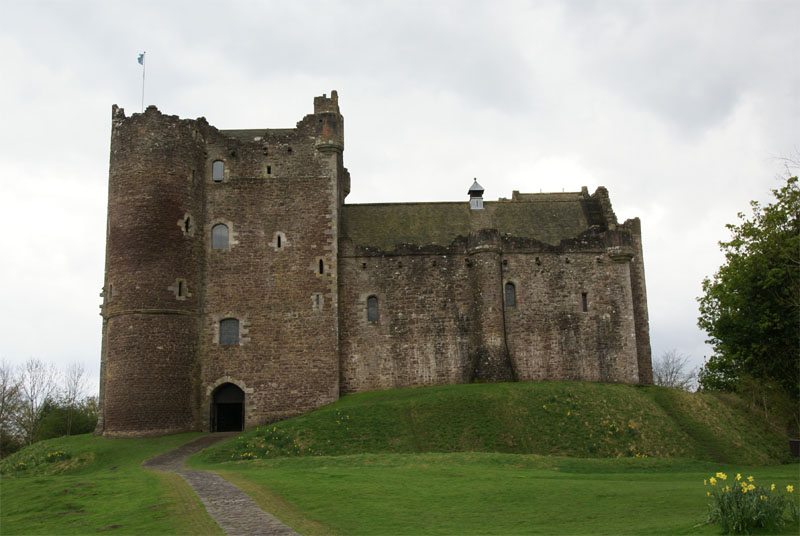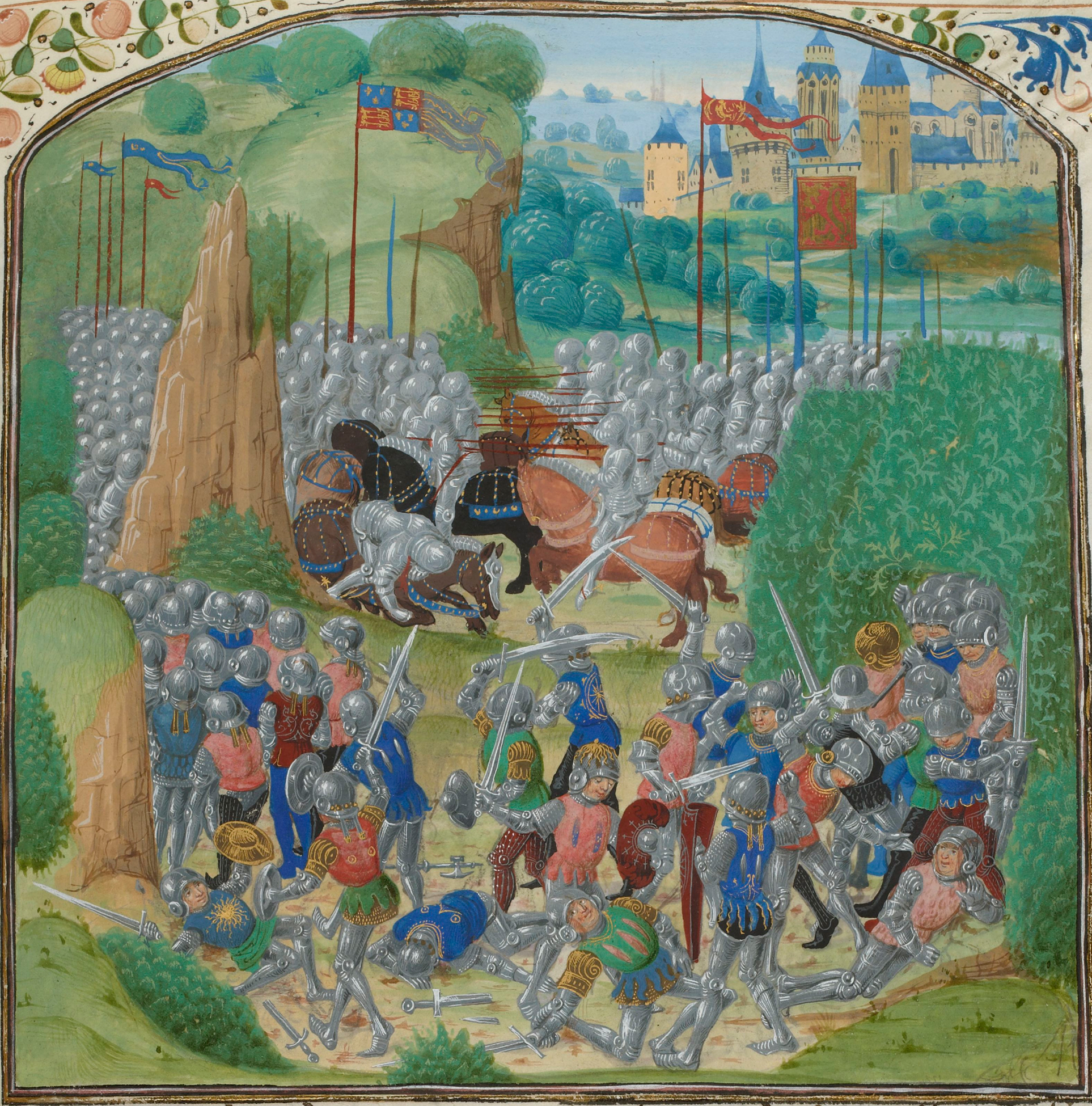|
Robert III Of Scotland
Robert III ( – 4 April 1406), born John Stewart, was King of Scots from 1390 to his death in 1406. He was also High Steward of Scotland from 1371 to 1390 and held the titles of Earl of Atholl (1367–1390) and Earl of Carrick (1368–1390) before ascending the throne at about the age of 53 years. He was the eldest son of King Robert II and Elizabeth Mure and was legitimized by the second marriage of his parents and by papal dispensation in 1349. John joined his father and other magnates in a rebellion against his great-uncle David II early in 1363 but submitted to him soon afterwards. He was married to Annabella Drummond by 1367. In 1368 David created him Earl of Carrick. His father became king in 1371 after the unexpected death of the childless King David II. In the succeeding years, Carrick was influential in the governance of the kingdom but became progressively more impatient at his father's longevity. In 1384 Carrick was appointed the king's lieutenant after swayi ... [...More Info...] [...Related Items...] OR: [Wikipedia] [Google] [Baidu] |
List Of Scottish Monarchs
The monarch of Scotland was the head of state of the Kingdom of Scotland. According to tradition, Kenneth I MacAlpin () was the founder and first King of the Kingdom of Scotland (although he never held the title historically, being King of the Picts instead). The List of kings of the Picts, Kingdom of the Picts just became known as the Kingdom of Alba in Scottish Gaelic, which later became known in Scots language, Scots and English as ''Scotland''; the terms are retained in both languages to this day. By the late 11th century at the very latest, Scottish kings were using the term , or King of Scots, to refer to themselves in Latin. The Kingdom of Scotland was merged with the Kingdom of England to form a single Kingdom of Great Britain in 1707. Thus, Anne, Queen of Great Britain, Queen Anne became the last monarch of the ancient kingdoms of Scotland and England and the first of Great Britain, although the kingdoms had shared a monarch since 1603 (see Union of the Crowns). Her un ... [...More Info...] [...Related Items...] OR: [Wikipedia] [Google] [Baidu] |
High Steward Of Scotland
Prince and Great Steward of Scotland is one of the titles of the heir apparent to the British throne. The holder since 8 September 2022 is Prince William, who bears the other Scottish titles of Duke of Rothesay, Earl of Carrick, Lord of the Isles and Baron of Renfrew. Principality of Scotland The Principality of Scotland originated in a time when Scotland was a separate kingdom prior to entering a political union with England in 1707. The title was held as an appanage by the heir apparent to the Scottish throne, and is still vested in the heir apparent to the British throne. In addition to being Prince and Great Steward of Scotland, the heir apparent is also Duke of Rothesay, Earl of Carrick, Baron of Renfrew, and Lord of the Isles. In modern times, the prince remains paramount superior in these lands (whilst the Crown serves this role in the rest of Scotland). The Abolition of Feudal Tenure etc. (Scotland) Act 2000, however, abolished most remaining feudal duties and priv ... [...More Info...] [...Related Items...] OR: [Wikipedia] [Google] [Baidu] |
Marjorie Bruce
Marjorie Bruce or Marjorie de Brus (1316 or 1317) was the eldest daughter of Robert the Bruce, King of Scots, and the only child born of his first marriage with Isabella of Mar. Marjorie's marriage to Walter, High Steward of Scotland, gave rise to the House of Stewart. Her son was the first Stewart monarch, King Robert II of Scotland. Early life Her mother, Isabella, was a noblewoman from the Clan Mar. Marjorie was named after her father's mother, Marjorie, Countess of Carrick. Soon after giving birth to Marjorie, at the age of 19, Isabella died."Elizabeth de Burgh and Marjorie Bruce". Foghlam Alba Marjorie's father was at that time the |
Heir Presumptive
An heir presumptive is the person entitled to inherit a throne, peerage, or other hereditary honour, but whose position can be displaced by the birth of a person with a better claim to the position in question. This is in contrast to an heir apparent, whose claim on the position cannot be displaced in this manner. Overview Depending on the rules of the monarchy, the heir presumptive might be the daughter of a monarch if males take preference over females and the monarch has no sons, or the senior member of a collateral line if the monarch is childless or the monarch's direct descendants cannot inherit either because #they are daughters and females are completely barred from inheriting #the monarch's children are illegitimate, or #some other legal disqualification, such as ##being descended from the monarch through a morganatic line or ##the descendant's refusal or inability to adopt a religion the monarch is required to profess. The subsequent birth of a legitimate child t ... [...More Info...] [...Related Items...] OR: [Wikipedia] [Google] [Baidu] |
Henry IV Of England
Henry IV ( – 20 March 1413), also known as Henry Bolingbroke, was King of England from 1399 to 1413. Henry was the son of John of Gaunt, Duke of Lancaster (a son of King Edward III), and Blanche of Lancaster. Henry was involved in the 1388 revolt of Lords Appellant against Richard II, his first cousin, but he was not punished. However, he was exiled from court in 1398. After Henry's father died in 1399, Richard blocked Henry's inheritance of his father's lands. That year, Henry rallied a group of supporters, overthrew and imprisoned Richard II, and usurped the throne; these actions later contributed to dynastic disputes in the Wars of the Roses (1455–1487). Henry was the first English ruler whose mother tongue was English (rather than French) since the Norman Conquest, over 300 years earlier. As king, he faced a number of rebellions, most seriously those of Owain Glyndŵr, the last Welshman to claim the title of Prince of Wales, and the English knight Henry Percy (Hotspur) ... [...More Info...] [...Related Items...] OR: [Wikipedia] [Google] [Baidu] |
Duke Of Albany
Duke of Albany is a peerage title that has occasionally been bestowed on younger sons in the Scotland, Scottish and later the British royal family, particularly in the Houses of House of Stuart, Stuart and House of Hanover, Hanover. History The Dukedom of Albany was first granted in 1398 by King Robert III of Scotland on his brother, Robert Stewart, Duke of Albany, Robert Stewart, the title being in the Peerage of Scotland. "Albany" was a broad territorial term representing the parts of Scotland north of the River Forth, roughly the former Kingdom of the Picts. The title (along with the Duke of Rothesay, Dukedom of Rothesay) was one of the first two dukedoms created in Scotland. It passed to Robert's son Murdoch Stewart, Duke of Albany, Murdoch Stewart, and was forfeited in 1425 due to the attainder of Murdoch. The title was again created in 1458 for Alexander Stewart, Duke of Albany, Alexander Stewart but was forfeit in 1483. His son John Stewart, Duke of Albany, John Stewa ... [...More Info...] [...Related Items...] OR: [Wikipedia] [Google] [Baidu] |
Duke Of Rothesay
Duke of Rothesay ( ; ; ) is the main dynastic title traditionally given to the male heir apparent to the Scottish and, later, British thrones. The dukedom was created in 1398 by Robert III of Scotland for his eldest son. Duke of Rothesay is the title mandated for use by the heir apparent when in Scotland, in preference to the titles ''Prince of Wales'' and ''Duke of Cornwall'', which are used in the rest of the United Kingdom and overseas. The title is named after Rothesay on the Isle of Bute, but is not associated with any legal entity or landed property. The Duke of Rothesay also holds other Scottish titles, including Earl of Carrick, Baron of Renfrew, Lord of the Isles, and Prince and Great Steward of Scotland. The current holder of the title is William, Prince of Wales, and his wife, Catherine, is the current Duchess of Rothesay. History David Stewart, Duke of Rothesay, the son of Robert III of Scotland, first held the dukedom from its creation in 1398. After his ... [...More Info...] [...Related Items...] OR: [Wikipedia] [Google] [Baidu] |
David Stewart, 1st Duke Of Rothesay
David Stewart (24 October 1378 - ) was the eldest son of Robert III of Scotland and his wife, Annabella Drummond. The heir apparent to the Scottish throne from 1390 until his death, David held the titles of Prince of Scotland, Duke of Rothesay, and Earl of Carrick. David was named by a general council to rule Scotland as regent, on behalf of his infirm and politically ineffective father, in 1399. He was responsible for the defense of Scotland during the English invasion in 1400. After coming into conflict with his uncle, Robert Stewart, Duke of Albany, David was arrested and removed from power in late 1401. He died in mysterious circumstances at Falkland Palace shortly afterwards. David's younger brother, James, eventually succeeded their father as King of Scots. Life David was born on 24 October 1378. He was the third child and eldest son of John Stewart, Earl of Carrick, himself the eldest son and heir apparent of King Robert II, and Annabella Drummond. David was proba ... [...More Info...] [...Related Items...] OR: [Wikipedia] [Google] [Baidu] |
Earl Of Fife
The Earl of Fife or Mormaer of Fife was the ruler of the province of Fife in medieval Scotland, which encompassed the modern counties of Fife and Kinross. Due to their royal ancestry, the earls of Fife were the highest ranking nobles in the realm, and had the right to crown the king of Scots. Held by the MacDuff family until it passed by resignation to the Stewarts, the earldom ended on the forfeiture and execution of Murdoch Stewart in 1425. The earldom was revived in 1759 with the style of Earl Fife for William Duff, a descendant of the MacDuffs. His great-great-grandson, the 6th Earl Fife, was made Earl of Fife in 1885 and Duke of Fife in 1889. Medieval earldom Mormaer of Fife The mormaers of Fife, by the 12th century, had established themselves as the highest ranking native nobles in Scotland. They frequently held the office of Justiciar of Scotia - highest brithem in the land - and enjoyed the right of crowning the kings of the Scots. The Mormaer's function, a ... [...More Info...] [...Related Items...] OR: [Wikipedia] [Google] [Baidu] |
Robert Stewart, 1st Duke Of Albany
Robert Stewart, Duke of Albany (c. 1340 – 3 September 1420) was a member of the Scottish royal family who served as regent (at least partially) to three Scottish monarchs ( Robert II, Robert III, and James I). A ruthless politician, Albany was widely regarded as having murdered his nephew, the Duke of Rothesay, and brother to the future King James I of Scotland. James was held in captivity in England for eighteen years, during which time Albany served as regent in Scotland, king in all but name. He died in 1420 and was succeeded by his son, Murdoch Stewart, Duke of Albany, who was executed for treason when James returned to Scotland in 1425, almost causing the complete ruin of the Albany Stewarts. Early life and ancestry Robert Stewart was the third son of the future King Robert II of Scotland (1316–1390) and of Elizabeth Mure of Rowallan. His parents' marriage was deemed uncanonical at first, which, in some circles, gave their children and descendants the label of il ... [...More Info...] [...Related Items...] OR: [Wikipedia] [Google] [Baidu] |
James Douglas, 2nd Earl Of Douglas
Sir James Douglas, 2nd Earl of Douglas and Earl of Mar, Mar (c. 1358 – 5 or 19 August 1388) was an influential and powerful magnate in the Kingdom of Scotland. Early life He was the eldest son and heir of William Douglas, 1st Earl of Douglas and Margaret, Countess of Mar. By the time his father had made over lands in Liddesdale to him in 1380, he had been knighted, being known as Sir James Douglas of Liddesdale. Earlier his father had been in dispute with Robert II of Scotland, King Robert over the latter's succession to King David II of Scotland, David II, but returned to royal favour by concluding a marriage contract between his son and the Princess Isabel, thus binding the Clan Douglas, Douglas family close to the throne. Earl of Douglas and Mar In May 1384, the 1st Earl of Douglas died from a fever, and his son inherited. Around the same time a Kingdom of France, French embassy arrived in Scotland to negotiate a truce between the Auld Alliance, Franco-Scots Allies and K ... [...More Info...] [...Related Items...] OR: [Wikipedia] [Google] [Baidu] |
Battle Of Otterburn
The Battle of Otterburn, also known as the Battle of Chevy Chase, took place according to Scottish sources on 5 August 1388, or 19 August according to English sources, as part of the continuing border skirmishes between the Scots and English. The Scottish nobles James, 2nd Earl of Douglas and John Dunbar, Earl of Moray led their army toward Durham while Archibald Douglas, 3rd Earl of Douglas at the time Lord of Galloway, and Robert Stewart, Duke of Albany, at the time Earl of Fife, coordinated a simultaneous attack on Carlisle Castle. It was timed to take advantage of divisions on the English side between Ralph Neville, 1st Earl of Westmorland and Henry Percy, 1st Earl of Northumberland who had just taken over defence of the border and partly in revenge for King Richard II's invasion of Scotland three years previously. Battle The Scots fielded two armies, with Archibald Douglas's force and their baggage train heading to attack Carlisle, while another force under t ... [...More Info...] [...Related Items...] OR: [Wikipedia] [Google] [Baidu] |





